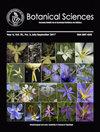墨西哥西部山地云和松栎林中脊椎动物对印度Persea hintonii C.K.Allen扩散后果实的去除模式
IF 0.7
4区 生物学
Q3 PLANT SCIENCES
引用次数: 0
摘要
背景:高传播后的水果种子去除可能是成功繁殖到分散分布的植物种群新区域的瓶颈,如云林。因此,了解植被和水果的进食行为将如何影响空间去除模式是很重要的。问题和/或假设:植被结构和密度如何影响潜在繁殖区的英仙座果实移除?研究地点和日期:Las Joyas科学站,Sierra de Manantlán生物圈保护区,墨西哥哈利斯科。2015年4月至5月。方法:在两种森林类型内林下茂密或稀疏的地区以及灌木覆盖的开阔地区,记录除不同大小脊椎动物外的处理中移除的果实数量。为了识别脊椎动物的除果物种,在结果量高的P.hintonii树的树冠下放置了相机陷阱。结果:松栎林低林下密度区(11.17±5.30%)和林隙区(25.5±2.39%)的除果率低于亚热带云雾林(72.51±0.60%)。林下植被茂密的云雾林和松栎林开始除果的天数低于林下植被稀疏的森林。我们确定了六种哺乳动物和三种鸟类是P.hintonii果实的去除剂,其中Pecari tajacu和小型哺乳动物是最重要的果实去除剂。结论:松栎林下低密度林下有利于减少辛托尼的果实去除,这可能与其消费者的行为有关。本文章由计算机程序翻译,如有差异,请以英文原文为准。
Pattern of post-dispersal fruit removal of Persea hintonii C.K. Allen by vertebrates in mountain cloud and pine-oak forests in western Mexico
Background: High post-dispersal fruit-seed removal can be a bottleneck for successful propagation to new areas of plant populations with fragmented distribution, as in cloud forest. Therefore, it is important to know how vegetation and fruit-eating behavior will influence the spatial removal pattern.
Questions and/or Hypotheses: How do vegetation structure and density influence fruit removal of Persea hintonii in potential propagation areas?
Study site and dates: Las Joyas Scientific Station, Sierra de Manantlán Biosphere Reserve, Jalisco, Mexico. April-May 2015.
Methods: The number of fruits removed were recorded in treatments excluding of different size vertebrates, in areas with a dense or sparse understory within two forest types plus open areas with shrub cover. To identify vertebrate fruit-removing species, camera-traps were placed under the canopy of P. hintonii trees with high fructification amounts.
Results: Fruit removal was lower in areas of low understory density at pine-oak forests (11.17 ± 5.30 %) and gap areas (25.5 ± 2.39 %), compared to subtropical cloud forests (72.51 ± 0.60 %). The number of days to start the fruit removal was lower in the cloud and pine-oak forests with dense understory than in those with a sparse understory. We identified six mammal and three bird species as removers of P. hintonii fruits, among which Pecari tajacu and small mammals were the most important fruit removers.
Conclusions: Low density understory in pine-oak favor less fruit removal of P. hintonii, probably associated with the behavior of its consumers.
求助全文
通过发布文献求助,成功后即可免费获取论文全文。
去求助
来源期刊

Botanical Sciences
Agricultural and Biological Sciences-Plant Science
CiteScore
1.90
自引率
21.40%
发文量
71
审稿时长
16 weeks
期刊介绍:
Botanical Sciences welcomes contributions that present original, previously unpublished results in Botany, including disciplines such as ecology and evolution, structure and function, systematics and taxonomy, in addition to other areas related to the study of plants. Research reviews are also accepted if they summarize recent advances in a subject, discipline, area, or developmental trend of botany; these should include an analytical, critical, and interpretative approach to a specific topic. Acceptance for reviews will be evaluated first by the Review Editor. Opinion Notes and Book Reviews are also published as long as a relevant contribution in the study of Botany is explained and supported.
 求助内容:
求助内容: 应助结果提醒方式:
应助结果提醒方式:


